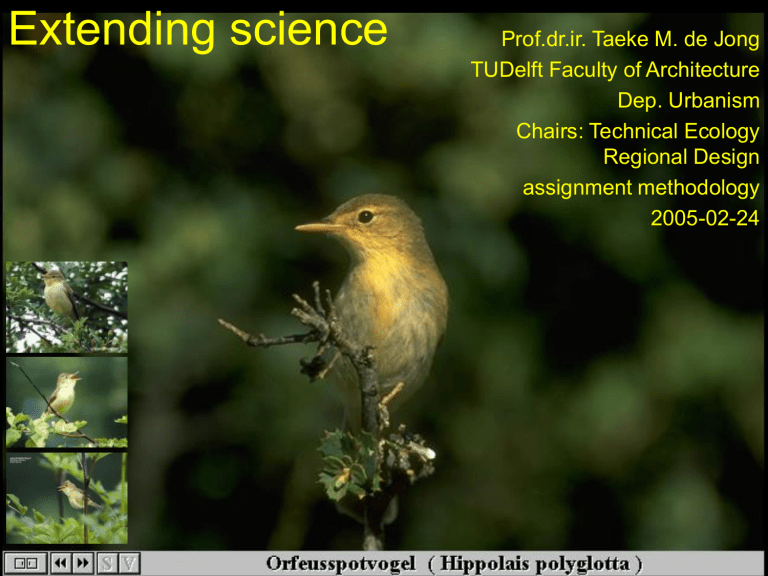
Extending science
Prof.dr.ir. Taeke M. de Jong
TUDelft Faculty of Architecture
Dep. Urbanism
Chairs: Technical Ecology
Regional Design
assignment methodology
2005-02-24
Extending science
Prof.dr.ir. Taeke M. de Jong
TUDelft Faculty of Architecture
Dep. Urbanism
Chairs: Technical Ecology
Regional Design
assignment methodology
2005-02-24
Imaginable
Creativiteit volgens
Herman Hertzberger
Een eenvoudig recept voor creativiteit komt van
architect Herman Hertzberger (1999, 2000, 2002):
1.verbreek het cliché,
2.verzamel veel beelden,
3.plaats ze in een andere context en
4.ga ze dan bewerken.
Verbreek het cliché
Robert Delaunay (1913)
Wijzig context (bijv. museum)
Marcel Duchamps (1917)
Combineer, laat weg, bewerk
Pablo Picasso (1942)
Referentiebeelden bewerken
Verwerken in een compositie
•
•
•
•
Verdelen (dividing)
Geleden (articulating)
Tailleren (tailoring)
Detailleren (detailing)
Verdelen, Geleden
Tailleren, Detailleren
inpassen in context
componenten en aansluitdetails
Compositie
• Componenten afbakenen, hun variatie en
Karakteristieke details,
• Aansluitdetails tussen componenten,
• Cruciale details in de compositie,
• Markante details bepalen.
10m
30m
100m
Varying components
Composition
Larger scale as context (museum,
movement)
Marcel Duchamps
Limits of scope (object and context):
Scale paradox
Unravelling scale
Spatial object in
social and
physical
Contexts
Ways to study
and research
urban,
architectural
and technical
design
Prof.dr.ir. T. M. de Jong
Dr. D.J.M. van der Voordt
Context sensitivity of our
design object
Preface by Rector Fokkema
Within the range of a technical
university the object of design – in terms
of (urban) architecture and technique –
is the design subject that is amongst all
others most sensitive to context.
The programme of requirements is not
only derived from an economical and
technical context, but also from contexts
hailing from political, cultural, ecological
en spatial considerations; on many
levels of scale.
Ways to Study and Research
urban, architectural and technical design
Empirical research
extending science
determined
determined Design Research
variable
Typological research
CONTEXT
Study by design
variable OBJECT
Design Study
Study by design
Probable future
Probable futures
There are more and less probable futures
Probability: core of classical science
s = 68%, 2s = 95%, 3s = 99.7% chance
Possible futures
Anything probable is per definition possible but
not everything possible is also probable.
The probable future could be predicted.
The improbable possibilities cannot be predicted:
you only can explore them by design.
Make probable by causes
Make possible by conditions
Not every condition is a cause, but every cause is a condition
for something to happen
Unravelling condition and cause
Desirable futures
Ir.
Drs.
Mr.
Obvious and Impossible futures
Field of problems, field of aims
Undesired, improbable possibilities
Are they relevant
as long as nobody
wants them?
Unexpected inventions
Yes
Changing desires
Domains of future
Domains
in design
science
Ways to Study and Research
urban, architectural and technical design
CONTENTS
Introduction
A. Naming and describing
B. Design research and typology
C. Evaluating
D. Modelling
E. Programming and optimising
F. Technical Study
G. Design Study
H. Study by design
Epilogue
determined
determined Design Research
variable
Typological research
CONTEXT
Empirical research
Study by design
variable OBJECT
Design Study
Study by design
Operational study proposals
•
•
•
•
•
•
y(x)
landscape( villa)
villa( landscape)
villa( landscape( water system))
urbanity( liveliness, choice)
( liveliness, choice)( density, variety)
Operations (functions) y= f(x)
•
•
•
•
•
•
•
•
•
•
intuitive: f(x):= associated with x
conditional: f(x):= possible by x
set-theoretical: f(x):= part of x, encloses x, without x ...
logical: f(x):= if x, not x ...
mathematical: f(x):= x+x , x2...
causal f(x):= caused by x
temporal: f(x):= preceded, followed by x
spatial(formal): f(x):= near to, contiguous to, surrounded by x ...
structural: f(x):= connected with x, seperated from x ...
combinations: a box of boards connected by nails:
box(boards, nails)
Valid, Reliable
Future impact

